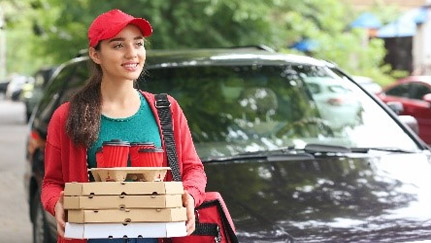Loss Control Learning Center
Restaurant delivery risk management

Restaurants who deliver food should have policies and procedures in place to prevent accidents and keep employees safe while making deliveries. The following are best practices organizations should have in place to reduce risk.
Vehicles and driving
- Contact your insurance agent to ensure you have the proper coverage. This is particularly important if your employees are driving their own vehicles or you are purchasing or renting additional vehicles.
- Make sure your driver has at least five years of driving experience, a valid driver’s license and an acceptable motor vehicle record: no DUIs, no major violations, and no more than three minor violations and accidents in the last three years.
- If employees are driving their own vehicles:
- Make sure the vehicle is owned by the employee or their parent; view the vehicle registration card.
- Verify that the vehicle is insured by requesting a certificate of insurance from the driver. Limits of $100,000/$300,000 for bodily injury and $100,000 for property damage are minimum
- Confirm the vehicle is in good condition by inspecting it and obtaining a copy of a valid inspection report from a state inspection agency or repair/service facility to confirm there are no outstanding safety issues.
- Establish safe driving policies such as: no cell phone use while driving, seatbelt requirement, no passengers, etc. Click here for sample rules.
- If using a third-party delivery vendor, you should:
- Have a written contract in place stipulating they are an independent contractor and favorable hold-harmless and indemnification wording.
- Require vendor to have workers compensation insurance and at least $1 million in general liability and auto liability limits. You should be listed as an additional insured on their policy and obtain a certificate of insurance.
General safety
- All payments should be electronic and made at the time of order. No cash transactions should occur during the delivery.
- Ensure orders are legitimate and recorded.
- Use a phone with caller ID and record the number when receiving a customer call.
- Record all order addresses and phone numbers so you know where your driver went.
- Look for suspicious orders: caller not sure about address or phone number, caller seems intoxicated, caller does not know what they want.
- Ensure drivers understand the importance of personal safety.
- Watch for suspicious activity while driving or at the delivery location.
- A driver should never make a delivery to a location where they feel unsafe.
- No deliveries to concealed or poorly illuminated areas. Call the customer to come out to get the order.
- No deliveries to hotel rooms; only lobbies. Use caution in multi-family complexes.
Delivering alcohol
- Follow all applicable federal, state and local liquor laws.
- The delivery person is to be at least 21 years of age and completed TIPS/TAMS training.
- Alcohol must be in an approved, sealed container before leaving the restaurant and through completion of the delivery.
- The person who is accepting the alcohol is to be at least 21 years old and must present valid identification to match the person’s name on the order.
- If the person accepting the alcohol is visibly intoxicated, the delivery should be cancelled.
Additional resources
Delivery Driver Safety Policies
Sample fleet safety/driver safety manual
Non-owned vehicle management
Monthly infographics for driver safety training
More industry resources
Subscribe to our newsletter for timely content in your inbox
